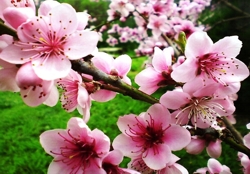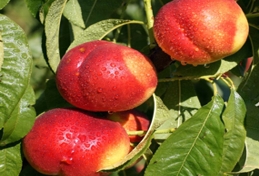| Perennial / Desiduous Trees / Nectarine Peach - Prunus persica Sweet |
|
|
|
|
| |
|
Plant name - Prunus persica
|

|
|
 |
|
 |
| Common name - Nectarines
|
| Plant type - Desiduous |
| Vegetation type -
Perennial |
| Growth rate - Medium |
| Leaf / Flower color
- Green / Pink |
| Other names - peach
|
| |
| Description : |
Prunus persica grows to 4–10 m (13–33 ft) tall and 6 in. in diameter. The leaves are lanceolate, 7–16 cm (2.8–6.3 in) long, 2–3 cm (0.79–1.18 in) broad, pinnately veined. The flowers are produced in early spring before the leaves; they are solitary or paired, 2.5–3 cm diameter, pink, with five petals.
The fruit has yellow or whitish flesh, a delicate aroma, and a skin that is either velvety (peaches) or smooth (nectarines) in different cultivars. The flesh is very delicate and easily bruised in some cultivars, but is fairly firm in some commercial varieties, especially when green. The single, large seed is red-brown, oval shaped, approximately 1.3–2 cm long, and is surrounded by a wood-like husk.
Peaches, along with cherries, plums and apricots, are stone fruits (drupes). There are various heirloom varieties, including the Indian peach, which arrives in the latter part of the summer.[
.
|
| |
| Growing Instructions : |
* Crack them by hitting them with a hammer, using a nut cracker or inserting them in a vice.
* Soak the seeds overnight in warm water to soften them. Place them in a small dish of moist potting soil or peat moss and put the dish in the refrigerator. In nature, seeds rest over the winter in the moist, cold soil. This process, known as scarification, breaks down the outer shell of the seed, hastening germination. The refrigerator provides an artificial means of scarifying the seeds.
* Check the seeds monthly. When you see fat, white roots in the soil, you'll know they've germinated. You can leave them in the refrigerator another month or so, or plant them. Plant the seeds in loose, moist potting soil in a pot or a wax milk carton with holes cut in the bottom.
* Place the seedlings in a warm, sunny location and water them frequently to keep the soil moist, but well-drained. Plant them outside after the last frost. Plant them in a sunny location with well-drained, fertile soil.
* Water the soil to keep it evenly moist and apply 1/8 lb. 10-10-10 fertilizer around the base of the plant one month after planting it. Thereafter, apply fertilizer every spring. Give trees three years old and younger 1/2 lb. fertilizer annually; give mature trees 3/4 lb. fertilizer annually.
* Prune trees in early spring to remove dead and diseased growth, control the tree's size and maintain an open form. Pruning improves air circulation and allows light to penetrate the tree's canopy. A properly cared for nectarine tree may produce fruit in three to five years.
|
| |
|
|
|
|
|
